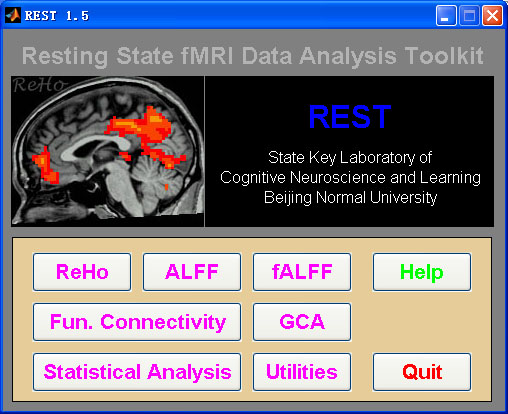fMRI培训班信息(详见附件)
- Read more about fMRI培训班信息(详见附件)
- Log in or register to post comments
- 5214 reads
老师,您好。
rest做FC时,用的是相关还是偏相关。
我查看了rest文件夹里的fc.m
里面有一部分求相关,直接用的是matlab内置的corrcoef
有一部分求相关用的是自己编写的函数。
这2个都是只是求相关的。不知道以后能不能导入求偏相关的函数
?
Professor Dan Lloyd
Does the Resting Brain Talk to Itself? Or Sing?
时间:2010-11-16,16:30
地点:北京师范大学脑成像中心三楼会议室
Biography
我使用dparsf进行ALFF的处理,跑完程序之后发现11个被试中有两个的分割结果不好,灰白质和脑脊液没有分离开,是模糊的,再看他们的功能像配准也有问题。由于之前做过VBM分析,当时是直接用spm分割的,相同的被试分割效果很好(详见下图)。回想起来,中间不同的是进行resting分析的时候多了结构像和功能像coregister这一步,想请教一下为什么这一步会带来这么大的变化呢,对于这两个被试resting图像的配准有什么其他的处理办法吗(如果还是想用分割配准)。
SORRY!I'm a newer!why and how to select ROI?
SORRY!I'm a newer!why and how to select ROI?
老师您好,我在使用slice viewer时遇到这样的情况:
按照教程的提示,我用slice viewer打开一幅ALFF双样本t检验的图,并进行了多重比较校正的相关设置。但是在看结果报表,也就是点击CL REPORT这个按钮后,不能如教程所述那样显示出相应的结果,在MATLAB中提示:
Number of clusters found: 9
??? Cell contents reference from a non-cell array object.
Error in ==> rest_sliceviewer>cuixuFindStructure at 4300
graylevel = DB{jj}.mnilist(index(ii, 1), index(ii, 2),index(ii, 3));
Error in ==> rest_sliceviewer>rest_report at 4146
[a, b] = cuixuFindStructure(tmpmni, x.DB);
Hi,
I am planning a study in which I want to measure two periods of resting state for each participants and want to compare them by means of paired-t-tests.
There are two ways of doing this: (1) stopping the scanner after the first resting period and restarting it for the second or (2) not stopping and restarting the scanner.
In task related fMRI one would not want to compare conditions that come from different scanning runs. Does the same apply for resting state? If so I assume that option (2) is better.
What would be your suggestion?
 |
Resting-State fMRI Data Analysis Toolkit (REST) is a convenient toolkit to calculate Functional Connectivity (FC), Regional Homogeneity (ReHo), Amplitude of Low-Frequency Fluctuation (ALFF), Fractional ALFF (fALFF), Gragner causality and perform statistical analysis. You also can use REST to view your data, perform Monte Carlo simulation similar to AlphaSim in AFNI, calculate your images, regress out covariates, extract ROI time courses, reslice images, and sort DICOM files. Download a MULTIMEDIA COURSE would be helpful for knowing more about how to use this software. Add REST's directory to MATLAB's path and enter "REST" in the command window of MATLAB to enjoy it.
The latest release is REST_V1.5_101101. |
New features of REST V1.5 release 101101:
1. Fixed a bug in rest_RegressOutCovariates_gui.m while processing multiple subjects with different covaribles in batch mode.
New features of REST V1.5 release 101025:
1. Module of Regional Homogeneity based on Coherence (Cohe-ReHo) has been added by LIU Dong-Qiang and DONG Zhang-Ye. For methodology, please see: Liu D, Yan C, Ren J, Yao L, Kiviniemi VJ and Zang Y (2010) Using coherence to measure regional homogeneity of resting-state fMRI signal. Front. Syst. Neurosci. 4:24. doi: 10.3389/fnsys.2010.00024.
2. In previous release of REST, removing covariates effects will also regress out linear trend. Now regressing out linear trend has been canceled in this step. Users can still regress out polynomial effects by using rest_regressOutCovariates.m in command line.
3. For rest_sliceviewer, fixed a bug of in displaying with MATLAB 2010 and support mouse wheel operation.
4. Fixed a bug in converting .nii files into NIfTI pairs (.img/.hdr).
5. Added new function of "corr(i1,i2,'spatial')" in REST Image Calculator.
6. Now can open a yoked structural image in displaying power spectrum.
7. Now can also pick up .nii files in GUI of reslice image.
.gif) |
Data Processing Assistant for Resting-State fMRI (DPARSF) is a convenient plug-in software based on SPM and REST. You just need to arrange your DICOM files, and click a few buttons to set parameters, DPARSF will then give all the preprocessed (slice timing, realign, normalize, smooth) data, FC, ReHo, ALFF and fALFF results. DPARSF can also create a report for excluding subjects with excessive head motion and generate a set of pictures for easily checking the effect of normalization. You can use DPARSF to extract AAL or ROI time courses (or extract Gray Matter Volume of AAL regions, command line only) efficiently if you want to perform small-world analysis. DPARSF basic edition is very easy to use, just click on buttons if you are not sure what it means, popup tips would tell you what you need to do. DPARSF advanced edition (alias: DPARSFA) is much more flexible, you can use it to reorient your images interactively or define regions of interest interactively. You can skip or combine the processing steps in DPARSF advanced edition freely. Please download a MULTIMEDIA COURSE to know more about how to use this software. Add DPARSF's directory to MATLAB's path and enter "DPARSF" or "DPARSFA" in the command window to enjoy DPARSF basic edition or advanced edition.
|
New features of DPARSF_V2.0_110505:
1. Fixed an error in the future MATLAB version in "[pathstr, name, ext, versn] = fileparts...".
New features of DPARSF_V2.0_101025:
1. DPARSF advanced edition (alias: DPARSFA) is added with the following new features:
1.1. The processing steps can be freely skipped or combined.
1.2. The processing can be start with any Starting Directory Name.
1.3. Support ReHo, ALFF/fALFF and Functional Connectivity calculation in individual space.
1.4. The masks or ROI files would be resampled automatically if the dimension mismatched the functional images.
1.5. The masks or ROI files in standard space can be warped into individual space by using the parameters estimated in unified segmentaion.
1.6. Support VBM analysis by checking "Segment" only.
1.7. Support reorientation interactively if the images in a bad orientation.
1.8. Support define regions of interest interactively based on the participant's T1 image in individual space.
2. DPARSF basic edition is preserved with the same operation style with DPARSF V1.0. DPARSF basic edition has the following new features:
2.1. Fixed a bug in copying "*.ps" files.
2.2. Will not check "wra*" prefix in "FunImgNormalized" directory.
2.3. Fixed a bug while regress out head motion parameters only.
The multimedia course for DPARSF advanced edition is estimated to be released in this November, thanks for your patience.